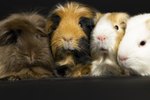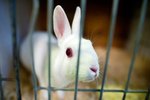
Dogs and cats are the most common pets in America, but other domesticated and semi-domesticated animals have wide followings. The USDA's Animal and Health Inspection Services estimates as many as 5 million rabbits are kept as pets by Americans. The dwarf lionhead leads the lagomorph herd with diminutive size, distinctive fur and winning personality.
Dwarf Lionheads

Rabbit owners are multiplying like bunnies, and the dwarf lionhead's particular popularity is easy to understand. First, he's cute -- really cute. Weighing in at under 4 pounds with a wool mane of fur circling his head, the dwarf lionhead seals the deal with a friendly, inquisitive personality. A relatively new breed, the rabbit first showed up in the U.S. in 2000. His popularity grew quickly with pet lovers, but under-education of the animal's needs is a significant problem, as rabbits have specific health concerns.
Hairballs

Dwarf lionhead rabbits are particularly susceptible to hairballs, a condition wherein the animal's fur is consumed, usually during molting, and becomes lodged in the digestive tract. With many animals, hair consumption is common; the animal will regurgitate the fur -- think of the cat's hairball. But rabbits, unlike cats, can't vomit the offending hair -- anything entering a rabbit's stomach has to travel the entire length of the gastrointestinal tract. Hairballs in a rabbit can block the intestine, preventing elimination, killing the rabbit. The dwarf lionhead, with his thick mane of hair, requires persistent grooming to prevent dangerous hairballs.
Obesity

Animal obesity is a serious and growing problem, and rabbits are no exception. Rabbits should not eat exclusively pellet food but should instead have unlimited hay, daily offerings of fresh greens such as kale or lettuce, and a controlled amount of pellets to round out feedings. Obese rabbits display low energy levels and can suffer from respiratory problems and arthritis; dwarf rabbits like lionheads are particularly prone to obesity -- smaller rabbits require less food and are easily overfed, while their tiny frame makes obesity less obvious than in larger rabbit breeds.
Tooth Problems

Rabbit teeth are “open rooted,” growing continuously throughout their lives. With front teeth, a insufficient diet of roughage, which is necessary for grinding down teeth, can result in incisors that grow too long and fatally puncture the skull. Rabbits' back teeth need grinding down to prevent misalignment. Dwarf lionheads are particularly prone to misalignment, as their heads were bred to be smaller and rounder, and can suffer from painful tooth spurs, mouth infection and eye problems. To prevent tooth issues, feed freely to the dwarf lionhead and chew items -- toys, branches, toilet paper rolls -- must be provided.
References
Resources
Photo Credits
-
Maria Teijeiro/Digital Vision/Getty Images
Writer Bio
Rodney Wilson is owner and manager of Goldfinch Farm in central Kentucky, where he oversees veterinary and management practices for a diverse group of animals, from dogs and cats to pigs and chickens. He's written professionally since 2001, with articles appearing in such publications as The Cincinnati Enquirer, CiN Weekly, Baby Guide and Akron Life.




